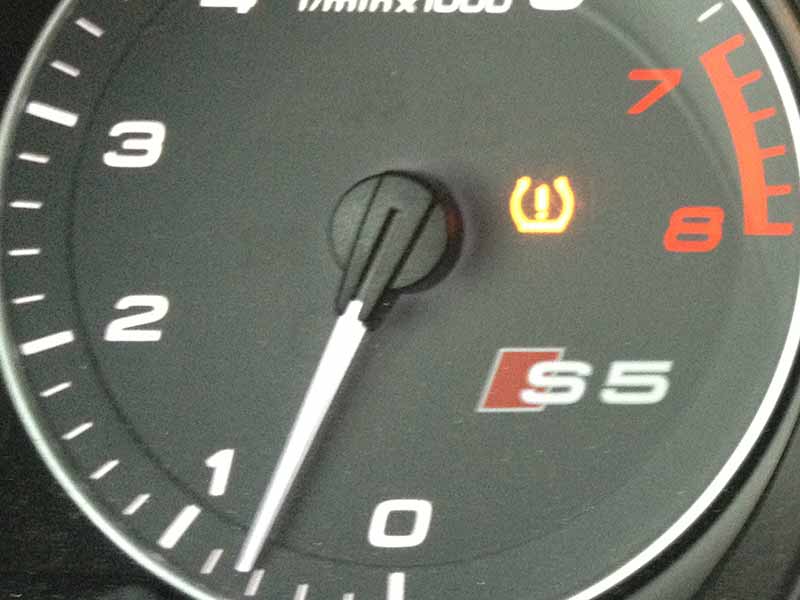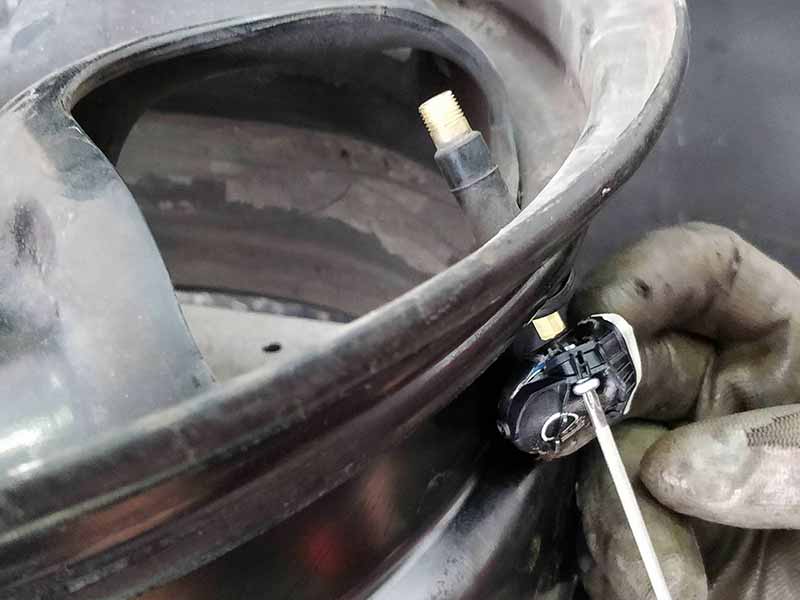After you rotate your tires, you often need to reprogram the tire pressure monitoring system so it knows where each wheel and pressure sensor moved.
Resetting by pushing the TPMS button inside your car or truck only clears any error codes that cause the tire warning light to show up on your dash.
How Do You Rotate Tires With TPMS?
How Do You Reset TPMS After Rotating Your Tires? Most TPMS systems need to relearn sensor positions after rotation. Often, simply pressing the TPMS reset button isn’t enough.
Often, the system requires a TPMS tool to tell the system the new locations of the rotated tires and tire sensors. Sometimes the system can automatically detect the locations.
The procedure for the system to relearn TPMS sensor positions will vary by manufacturer and even sometimes between different models from the same manufacturer.
Your owner’s manual will have the steps necessary for your unique vehicle.
Continue reading to learn more about some of the more common methods of training a tire pressure monitoring system to relearn TPMS sensor positions after tire rotations.

Rotating Tires With TPMS
Many vehicles with a tire pressure monitoring system will need to relearn the TPMS sensor positions after rotating their tires. But not all will need to do so. There are 2 types of TPMS (direct and indirect) and only direct TPMS needs to relearn sensor positions.
If you have had your tires rotated at a service center and are experiencing a TPMS warning light, you should return to the service center to have them sort the problem out since this is part of the service.
If you performed the tire rotation yourself, you’ll need to check your owner’s manual for the correct procedure for training your tire pressure monitor in the new positions of the TPMS sensors.
How Does TPMS Know Which Tire Is Which?
Each sensor in a direct tire pressure monitoring system has a unique identifier that it broadcasts along with the air pressure within the tire.
When the system is first set up, each sensor is registered with the monitoring system with its location.
If the positions of the tires are moved, such as when tires are rotated, the tire pressure monitor needs to relearn the positions.
The method of relearning or training the monitoring system for the new positions is very different for each vehicle manufacturer.
Do You Need To Reset TPMS After Tire Rotation?
You only need to reset your tire pressure monitoring system after rotating your tires if the tire pressure between your front and rear tires is different and needs to be adjusted.
If you had to adjust your tires to the correct tire pressure, you may also need to reset the tire pressure monitor system.
Resetting a TPMS system only affects the tire pressures and doesn’t affect the TPMS sensor positions.
Does TPMS Need To Relearn After Tire Rotation?
Many tire pressure monitoring systems will need to relearn where the TPMS sensors are located after tire rotations. Not all will need to do this, however.
Some systems relearn the new tire positions automatically while others will need a series of steps to be performed to train the monitoring system where each wheel assembly has been moved.
Unfortunately, each manufacturer has a unique procedure for programming the system to instruct it where each TPMS sensor is located.

TPMS Reset Vs Relearn (Training)
Resetting your tire pressure monitor and it relearning the location of each of the TPMS sensors are two different functions.
TPMS Reset
Resetting your tire pressure monitor will clear error codes, but it does not solve your problem. You need to check the air pressure in each tire and ensure it matches the pressures listed in the driver’s door jamb.
If the pressures are correct, you can safely hit the reset button located in your car or truck to clear the error code.
TPMS Relearn
Each vehicle manufacturer has a unique method of programming the locations of the rotated tires and sensors into the monitoring system.
We can’t cover every make and model in this article. You can find out the specific steps required to set the new sensor locations in your system in your car or truck owner’s manual.
How To Relearn TPMS Sensor Positions
As mentioned, we can’t cover every type of car and truck here, but we can describe some of the more common ways that tire monitoring systems are reprogrammed with the new tire locations.
The relearning process is unique to each Direct TPMS system. Different makes and models of cars or trucks will have different systems with different relearning processes. Some will require a tool while others may not.
TPMS Relearn Tool
Many manufacturers, such as GM and Ford, require a TPMS tool for resetting the locations of your tire sensors.
You’ll need to refer to your vehicle’s owner’s manual or do a little googling to determine the procedure for your unique car or truck. If you happen to have a vehicle that requires the use of a tool, you may be able to rent one from your local auto parts store, borrow one from a friend, or you may need to purchase one.
Some TPMS relearning and programming tools are inexpensive while others can cost quite a lot of money. If you find you need one of these tools to properly relearn the wheel positions and the tool is unusually expensive and can’t be found any other way, I recommend going to your local tire shop and paying them to update the wheel positions for you.
Relearn tools are usually placed next to the valve stem, where the TPMS sensors are usually located and are used to force the sensor to broadcast when prompted by the system.
The steps and procedures can be more or less complicated depending on the sophistication of the system in your vehicle and the abilities of the tool required.
TPMS Relearn Without Tool
Some tire pressure monitoring systems don’t require a tool and can learn the new positions automatically. This often requires instructing the system to search for the new sensor positions, but not always.
Sometimes you can simply drive for a period of time and the system will find the new positions.
Even if you do have to initiate the relearn procedure, you usually have to drive the vehicle for a while to activate the sensors long enough for the system to correctly locate the sensors and assign them in the system.
Older systems may require releasing air from the tires in a specific order so the system can identify the tires based on the pressure change.

Direct Vs Indirect Tire Pressure Monitoring System
Direct and Indirect are the two methods used for monitoring the air pressure in your tires. Direct TPMS is very accurate and reliable. Indirect TPMS guesses that there’s an air pressure problem based on factors other than the actual pressure.
Direct TPMS
A direct TPMS system has TPMS sensors in each tire and will report the exact air pressure for each. These sensors are usually located at the base of the valve stem. Sometimes they are strapped to the inside of the wheel barrel with a metal band.
The sensors contain batteries that allow them to report individual tire pressures to the tire pressure monitor wirelessly.
Each TPMS sensor needs to be identified by its location in the tire pressure monitor for it to be able to correctly report the pressure for each of the four tires.
A direct TPMS system will need to relearn these positions to be able to function properly.
Indirect TPMS
Indirect TPMS doesn’t check air pressure and uses the anti-lock brake system sensors to determine which tire is spinning at a different speed. The assumption is that a tire that spins at a different speed than the other three tires has lost air pressure.
This system is obviously less accurate and can not report actual air pressure. It can also not report problems such as all four tires losing pressure at the same time, since the tire speed of each will be the same.
Resources
Below are some links you may find helpful when learning about tires
- What is TPMS & how does it work? – Bridgestone
- The trials of installing winter tires with tire pressure sensors – Motor Trend
Final Thoughts
While it would be nice if manufacturers could all make TPMS sensors automatically report their new positions after tire rotation, that unfortunately isn’t the case yet. Some are lucky enough to be in this position, however.
Drivers with indirect TPMS won’t need to worry about sensor position, but they may still want to reset the monitoring system. Others will need to use a tool to program the system.
No matter what car or truck you drive, you should check your owner’s manual for the steps you need to take after rotating your tires.
And, if you had your tires rotated by a tire shop, dealership, or somewhere with a service technician or mechanic of some kind, take your car or truck back there if you’re experiencing a TPMS warning light on your dash.





